Fast Wind Storming with More to the East & West | Solar Storm Forecast 01.17.2022
This Space Weather News forecast sponsored in part by Millersville University:
https://www.millersville.edu/swen
The Sun has Earth in its' crosshairs this week! We've had no less than three solar storms to contend with all in the past few days. The first solar storm was launched by region 2925 back on January 14 and was supposed to hit yesterday, but it missed Earth, thanks to the fast solar wind from the large coronal hole passing through the Earth-strike zone now. Likely that fast wind stream deflected the solar storm to the west of Earth. But no matter, the fast wind has been sporadically bumping us to storm levels off and on over the past couple days. We even reached G2-level conditions for about three hours right around the 15th, but don't be fooled, as these conditions were more bark than bite. Even aurora chasers had a difficult time catching much more than a glimpse of aurora at mid-latitudes. Still this storm will keep us on our toes over the next couple days, plus we have yet another solar storm on the way. This one was launched by region 2929 in the north. This new solar storm has a better chance of hitting Earth than the previous one did, but it still could be a glancing blow around the 20th. In addition, we have no less than seven active regions on the Earth-facing Sun, which is keeping solar flux boosted into the triple digits and allowing decent radio propagation on Earth's dayside. Big flares and radio blackouts are a slight risk now, but it is not too bad for GPS reception overall. Learn the details surrounding all of this activity and see what else our Sun has in store. Want early access to these forecasts, tutorials on Space Weather, & more? Visit:
https://patreon.com/SpaceweatherWoman
For daily and often hourly updates (during active times) visit me on Twitter:
https://twitter.com/TamithaSkov
For a more in-depth look at the data and images highlighted in this video see these links below.
Solar Imaging and Analysis:
SDO: http://sdo.gsfc.nasa.gov/data/
Helioviewer: http://www.helioviewer.org/
Flare Analysis: http://www.lmsal.com/solarsoft/latest_events/
Computer Aided CME Tracking CACTUS: http://www.sidc.oma.be/cactus/out/latestCMEs.html
GOES Xray: http://www.swpc.noaa.gov/rt_plots/xray_1m.html
SOHO: http://sohodata.nascom.nasa.gov/
Stereo: http://stereo.gsfc.nasa.gov/
GONG magnetic field synoptic movie: https://gong.nso.edu/data/magmap/standard_movie.html
GONG magnetic field synoptic charts: http://gong.nso.edu/data/magmap/
LMSAL Heliophysics Events HEK http://www.lmsal.com/isolsearch
Solar Wind:
DISCOVR solar wind: http://www.swpc.noaa.gov/products/real-time-solar-wind
ACE Solar Wind: http://www.swpc.noaa.gov/products/ace-real-time-solar-wind
NASA ENLIL SPIRAL: https://iswa.gsfc.nasa.gov/IswaSystemWebApp/iSWACygnetStreamer?timestamp=2038-01-23+00%3A44%3A00&window=-1&cygnetId=261
NOAA ENLIL SPIRAL: http://www.swpc.noaa.gov/products/wsa-enlil-solar-wind-prediction
Magnetosphere, Ionosphere, Atmosphere:
GOES Magnetometer: http://www.swpc.noaa.gov/products/goes-magnetometer
Ionosphere D-Region Absorption (DRAP) model: http://www.swpc.noaa.gov/products/d-region-absorption-predictions-d-rap/
Auroral Oval Ovation Products: http://www.swpc.noaa.gov/products/aurora-30-minute-forecast
Global 3-hr Kp index: http://www.swpc.noaa.gov/products/planetary-k-index
Wing Kp index prediction: http://www.swpc.noaa.gov/products/wing-kp
USGS Ground Magnetometers: http://geomag.usgs.gov/realtime/
USGS Disturbance Storm-Time (Dst): http://geomag.usgs.gov/realtime/dst/
NAIRAS Radiation Storm Model: http://sol.spacenvironment.net/raps_ops/current_files/globeView.html
Multi-Purpose Space Environment Sites:
NOAA/SWPC: http://www.swpc.noaa.gov
SOLARHAM: http://www.solarham.net/index.htm
Spaceweather: http://spaceweather.com
iSWA: http://iswa.gsfc.nasa.gov/iswa/iSWA.html
Definition of Geomagnetic Storm, Radiation Storm, and Radio Blackout Levels:
http://www.swpc.noaa.gov/NOAAscales/
None of this would be possible without the hard work and dedication of those who have provided all of this data for public use.
Images c/o NASA/ESA/CSA (most notably the superb SDO, SOHO, ACE, STEREO, CCMC, JPL & DSN teams, amazing professionals, hobbyists, institutions, organizations, agencies and amateurs such as those at the USAF/HAARP, NICT, NOAA, USGS, Environment Canada, Natural Resources Canada, Intellicast, Catatania, rice.edu, wisc.edu, sonoma.edu ucalgary.ca, rssi.ru, ohio-state.edu, solen.info, and more. Thanks for making Space Weather part of our every day dialogue.
-
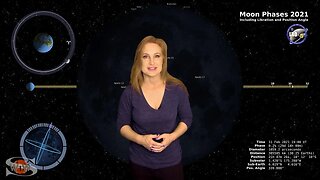 10:17
10:17
Dr. Tamitha Skov
3 years agoFast Solar Wind Coming in Waves | Solar Storm Forecast 02.04.2021
10 -
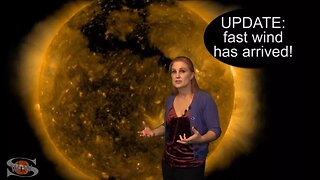 5:37
5:37
Dr. Tamitha Skov
6 years agoFast Wind Returns Bringing Aurora: Solar Storm Forecast 10-12-2017
61 -
 3:07
3:07
MadMalloy
1 year agoSolar Wind Disturbance, USA Storm Forecast | S0 News Apr.19.2023
91 -
 10:32
10:32
NaturesFury
2 months agoUSA NOW! April's Fury: Devastating Storms Strike Central & Eastern US! Witness the Chaos Unfold!
77 -
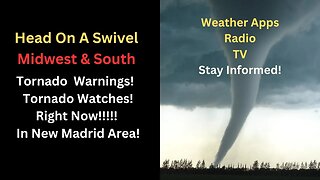 6:55
6:55
PhoenixStar777
1 year agoMidwest and South - Tornado Warnings and Tornado Watches Tonight
259 -
 28:04
28:04
WeathermanPlus
2 years agoWarning! Multiple Cyclones Next Week, 100 MPH Winds & More! - The WeatherMan Plus Weather Channel
110 -
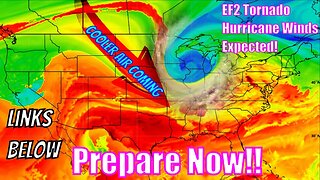 21:33
21:33
WeathermanPlus
10 months agoPrepare For This! EF2 Tornadoes & Hurricane Winds Expected! - The WeatherMan Plus
515 -
 3:00:58
3:00:58
The David Knight Show
1 year ago4Apr23 Forecast: Stormy With 100% Chance of Arraignment Followed by Strong Winds From Every Direction
5.57K28 -
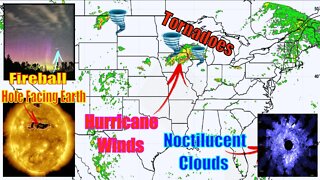 20:56
20:56
WeathermanPlus
1 year agoGeomagnetic Storm, Fireball, Hurricane Winds & Tornado Threat! - The WeatherMan Plus Weather Channel
146 -
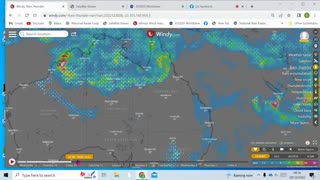 24:18
24:18
HAARP Hunters - GeoEngineering Watch
1 year ago🚨 Heads Up East Coast NSW 📡 Your Geoengineered Weather 💦 Daily Update 🌪
6471